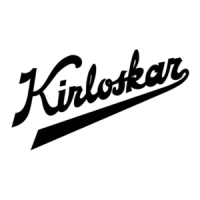7.7 SHAFT SEAL:
The shaft seal should be inspected after about 4,500
hours' running. In most cases only the rubber '0' rings
will have to be renewed, to ensure that a reliable seal is
maintained.
7.8 OIL PUMP:
The oil pump should be completely dismantled after
every 9,000 hours' running. Various parts of the pump
will have become dirty during that period, impairing its
efficient operation, and producing unnecessary wear if
not rectified. Ensure that the oil pump is reassembled
correctly. Incorrect operation of the oil pump will cause
faulty lubrication and malfunctioning of the compressor
controls. This may result in additional wear, or even
damage to the compressor.
NOTE: On dismantling, the gears should be marked so
that while reassembling, it is possible to refit them in
exactly the same way. This is necessary as the gears are
meshed to each other.
7.9 OIL STRAINER:
When the compressor is put into operation for the very
first time the suction oil strainer to be cleaned and
delivery oil strainers must be replaced after the first 4, 8,
50, 100 hrs. of running. Afterwards the strainers if
remains practically clean, then they should be
cleaned/replaced after every 500 hrs.
7.10 REFRIGERANT SUCTION STRAINER:
After the initial start of the compressor, this strainer
should be cleaned during the first week after every 8
hours' running, then after every 25 hours' running, until
when practically no dirt and scale is trapped. Finally
every 500 hours' running. For this purpose the suction
stop valve and the stop valve on the automatic oil return
from the oil separator should be shut, and the
compressor evacuated. After shutting the delivery
pressure gauge stop valve, the H.P. pressostat should be
disconnected (if fitted). A hose leading to the open air
should be connected to the delivery pressure gauge stop
valve, after which the delivery stop valve should be shut
out not before the suction pressure gauge indicates a
vacuum of at least 700 mm. mercury. The pressure
gauge stop valve should be opened to allow any
remaining gas to be pumped to atmosphere.
After stopping the compressor, the bolts securing the
strainer housing cover should be removed. The cover
can then be eased with a screw driver to break the
vacuum. The cover can then be taken off and the strainer
removed and cleaned. After replacement, the
compressor should be purged.
7.11 LUBRICATION INSTRUCTIONS:
It is very important to pay full attention to the
lubrication of compressor. The lubrication record chart
will be of great assistance provided that the records are
accurately filled in all the time. With the aid of this
record, time of oil renewal, as well as the consumption,
can be checked.
Check/Change oil after 4,8,50,100 hrs.
running after the initial start of the compressor. Then
after a further 400 hours' running and then after every
1,500 hours' running.
Never mix different brands of oil.
Topping up may be carried out with the compressor
operating, without interrupting the operation of the
refrigerating plant, provided an additional separate oil
pump is available. This is connected to the oil charging
stop valve for this purpose.
Topping up by means of crankcase evacuation by the
compressor itself causes only a short interruption in
plant operation, provided a drum of the oil is connected
to the oil charging stop valve before closing the suction
stop valve. After shutting the suction stop valve
crankcase pressure will fall. When this pressure has
fallen below atmospheric, the oil charging stop valve
should be opened. When the oil level reaches the centre
of the oil level glass the oil charging stop valve must be
closed. The suction stop valve should then be opened
very slowly.
Renewal of the oil should be carried out with the
compressor stopped (at working temperature). Before
opening the crankcase it should be evacuated to remove
the refrigerant gas.
While the compressor is operating regularly check the
oil pressure indicated on the oil pressure gauge, the oil
level and the oil return jet behind the oil level glass. The
2
oil pressure must be 1.5 Kgf/cm g above crankcase
pressure. Behind the oil level glass a steady and regular
oil return jet should be visible. The level should always
be visible in the oil level glass.
Half an hour after the initial start, the oil strainers should
be cleaned then, for some days, after every 4 hours'
running. Then the strainers remain virtually clean till
500 hours' running and required to be cleaned again after
that. For brands of oil see the lubricating chart.
7.12 GENERAL INSTRUCTIONS :
1. Evacuate the compressor before carrying out
maintenance.
2. Purge the compressor after the maintenance as
follows a.
a. Close the suction & delivery stop valve.
b. Disconnect delivery pressure line from delivery
manifold and start the compressor.
c. Wait until compressor comes to vacuum of
730/740 mm of Hg.
d. Reconnect delivery pressure gauge to
compressor if delivery pressure gauge reading,
increases. disconnect it momentarily. When the
pressure no longer rises appreciably reconnect
delivery pressure gauge permanently.
e. Slowly open delivery stop valve and then
suction stop valve.
h. Restart compressor for about five minutes.
i. Purge the refrigeration plant.
3. Clean/replace oil strainers thoroughly every 500 hrs.
of running.
4. Clean suction gas strainer with duration identical to
oil strainer after initial start. 5. Clean the
crankcase/oil pump throughly at each time of oil
removal.
6. Duration between two successive cleaning of oil
strainers, suction gas strainer and renewal of oil
depends upon presence of dirt in the system.
7. In case the compressor is either kept in stock or idle
for more than 6 months, it is essential to clean to
compressor thoroughly before the commissioning.
Note : Discharge oil filters are special type paper filters
and are not to be cleaned & reused but to be replaced
only.
MAINTAIN "LOG SHEET" AS GIVEN ON NEXT
PAGE
CAUTION
24

